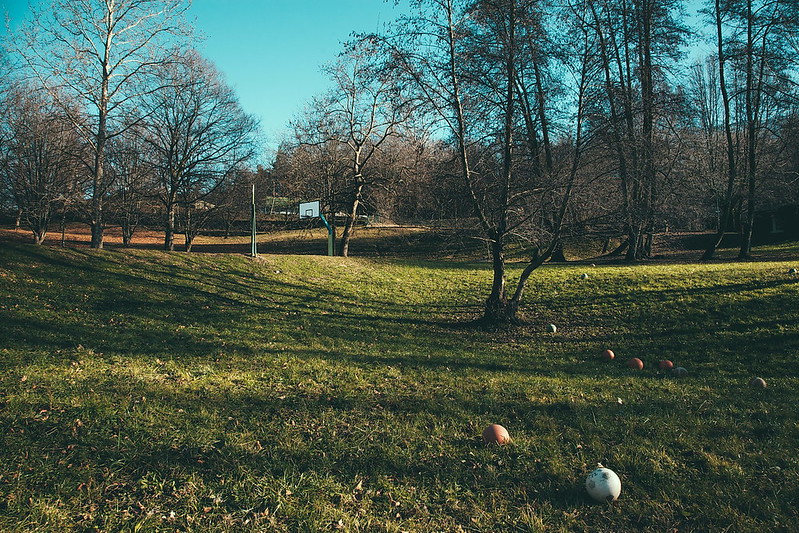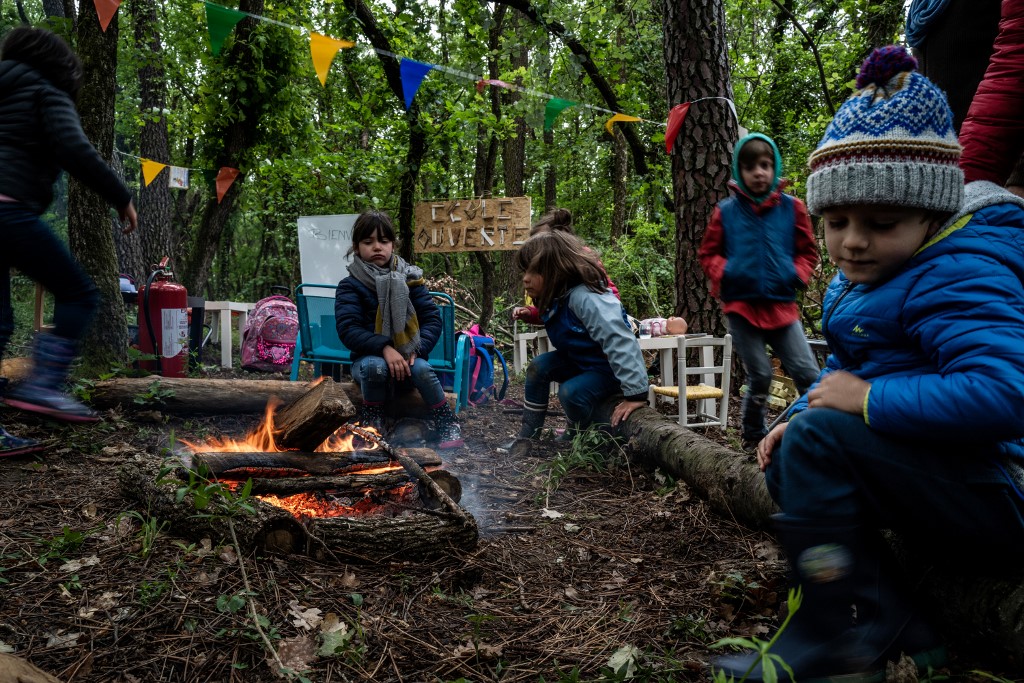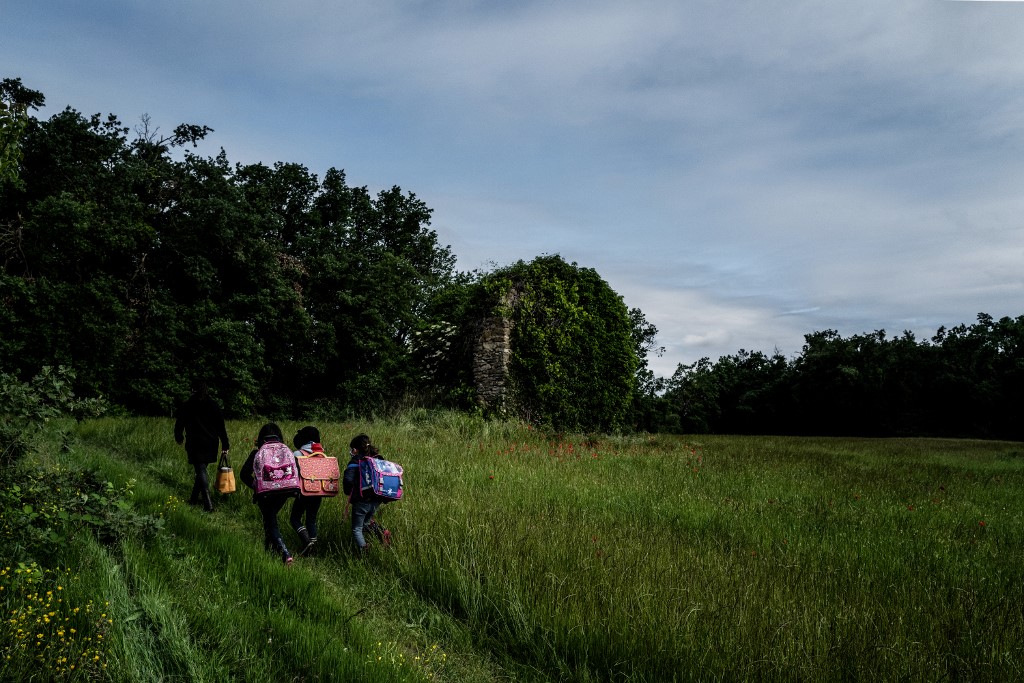Can outdoor teaching enable Italy to safely reopen schools?

As Italy debates how to reopen schools after its strict Covid-19 lockdown, teaching outside is one of the solutions being suggested to help kids return safely to class. Jessica Phelan heard from teachers and parents already involved in outdoor education to find out what’s really involved and how it might work.
In the last week of May, while most pupils in Italy were still doing classes via computer, children at two kindergartens in Piedmont were examining the magnolias and counting snails on the school lawn.
The kindergartens, Don Milani and Sant'Antonio in the town of Ivrea, are two of the only nurseries, schools or universities in Italy to have allowed kids back through the gates since March. Most still haven’t; by the time pupils return in mid-September, it will be for the first time in more than six months.
The reason they were able to invite children back is because they kept them outside, one of the strategies that’s being considered to help Italy reopen its schools while controlling the risk of another devastating coronavirus outbreak.

High school students in Rome wait to take their final exams on the school's basketball court. Photo: Tiziana Fabi/AFP
Balancing the need for social distancing with the determination to return pupils to real classrooms after three months of online lessons only will mean significantly rethinking schools’ physical space.
The Ministry of Education’s scientific committee has recommended that each school should “map and reorganize its own spaces … also making use of additional spaces through collaborations with local authorities”.
The obvious place to seek extra space is outside. Moving lessons outdoors is one of the World Health Organisation’s recommended measures for reopening schools, corresponding to research that suggests the large majority of infections occur indoors.
Epidemiologists say that’s because the viral particles released from an infected person’s mouth or nose more rapidly fall to the ground or get diffused outdoors, where there are fewer surfaces to catch them and more fresh air circulating.
While heading outside doesn’t eliminate the risk of transmitting the new coronavirus, it is one of the strategies that Denmark has successfully employed since becoming the first country in Europe to reopen primary schools, nurseries and kindergartens, in mid-April.
READ ALSO: How Denmark got its children back to school so soon after lockdown
Danish teachers were encouraged to move lessons as well as breaks outdoors as much as possible, alongside extra hygiene measures and limits on physical contact. So far Denmark’s school reopening “has proven to be very safe”, epidemiologist Christian Wejse of Aarhus University told The Local six weeks in.
In Piedmont, the Italian region with the second-highest number of coronavirus cases, teachers in Ivrea tried out many of the same measures adopted in Denmark. In their trial reopening, 3-6 year olds were separated into groups of five who had their own teacher, zones and bathrooms that weren’t shared with anyone outside their “bubble”.
Hands and faces were washed at frequent intervals, while play equipment was disinfected after each use. Drop-off and pick-up times were staggered to minimise contact between families and parents weren’t allowed beyond the gates, while the day was reduced to 8am-1pm.
Above all, except for using the bathroom, the children never went inside.
A summer of experiments
Originally planned to last four days, the programme was extended for another two weeks and expanded from 20 children to 30. The municipality hailed the trial’s “excellent results” and said it had received considerable demand for the service from local families.
“The kids were overjoyed, the parents relieved that they could leave the kids with someone they knew and trusted,” says Vittoria Burton of Alce Rosso, a local cooperative already experienced in outdoor education that coordinated the project on behalf of the town council and supplied its own specially trained educators.
Thanks to a grant from a private foundation, the non-profit was also able to provide a similar outdoor programme for a further 40 children on its own grounds in the Villa Girelli, a sweeping park built for the children of workers at Olivetti’s nearby manufacturing hub. This week it started a summer camp for under-3s, “so we'll have a full summer to experiment,” Burton tells The Local.

Villa Girelli was designed as a park for workers' children within the Olivetti complex in Ivrea. Photo: bass_nroll via Flickr, CC BY-NC-ND 2.0
But while parents may be happy for children to spend a few weeks outside in summer, they might feel differently as autumn approaches and the school year begins in earnest.
Does outdoor education have a longer-term future in Italy, which doesn’t have the tradition of forest schools that Denmark does, which spends less on education per inhabitant, and where teaching methods are notoriously slow to change?
“In this post-Covid phase we’ve had a lot of people getting in touch, to understand what kind of training you can undertake to foster outdoor education,” says Filomena Massaro, director of Italy’s National Network of Outdoor Schools, which currently counts around 40 public primary and lower secondary schools among its members.
Massaro, who is herself a head teacher at an istituto comprensivo (kindergarten to high school) in Bologna, points out that it’s not as simple as taking kids out to the school courtyard.
“Because this is what has been said, just: ‘go back to school, but do it outdoors’. But [...] outdoor education means having an educational project, in which there is also a flexible approach to the way days are organized.”
That means being prepared to rethink plans if the weather changes or if children are drawn to a different activity, she explains. And more fundamentally, it involves encouraging children to learn through experience, by exploring, coming up with their own hypotheses and testing them out – a world away from the lecture-style lessons that tend to dominate Italian schools.
'Kids have trouble with freedom as well'
At Padre O. Marella primary school where Massaro’s colleague Laila Evangelisti teaches 9-10 year olds partly outdoors, her classes aren’t divided into subjects – one hour for Italian, one hour for maths, etc – but are interdisciplinary.
Studying the history of Ancient Egypt might lead to recreating early measuring devices and testing them out, leading into learning mathematical concepts like metres and centimetres. And rather than a fixed programme, Evangelisti gives her students “a series of inputs” that may or may not lead in the direction she expects.
“That’s what we understand as the real point... allowing more freedom of choice for the students, allowing them to freely explore and kind of drive their own learning. And it’s definitely difficult to do that within the constraints of the curriculum,” says Tory Dandrige, a high school biology teacher at Marymount International School in Rome, which opened its own forest school a few months before the pandemic in autumn 2019.
Most outdoor education is geared towards younger children, who have a broader curriculum and fewer exams. That doesn’t mean it can’t work for older pupils, but among secondary teachers at Marymount “because it was a little bit more difficult and they were unfamiliar with it there was some reluctance to use the space,” says Dandridge.
Teaching outdoors can be daunting at any grade, she acknowledges: for teachers, who have to keep students safe and focused in a new environment, but also for pupils, who may not be used to not being told exactly what to do.
“They really enjoy it, but kids have trouble with freedom as well, I’ve noticed. It’s letting them know that it’s ok to explore, it’s ok to have not exactly the right answer sometimes. That’s hard for them sometimes.”

'Everything will be ok': children in Italy have been away from school longer than any others in Europe. Photo: Marco Bertorello/AFP
There are also parents to consider, who are perhaps less accustomed to risk taking than their counterparts in Denmark, where children are typically encouraged to play independently from a young age.
While Marymount carries out regular risk assessments on its forest school, “we can’t take away the risk because forest school is about risk taking too,” says Julie Finan, who is responsible for coordinating outdoor learning for the school’s youngest pupils. The school invited parents to a meeting in the proposed space to get them on board, she says, while she completed specialised training in the UK that helped prepare her to lead lessons safely.
In Bologna, Massaro says, the infant school she directs invited paediatricians to speak to parents about the benefits of outdoor learning for developing psychomotor skills. The school takes children outdoors in autumn and winter as well as in warmer months, so parents need to know what arrangements are in place for bad weather. “Families must be involved, they must feel reassured,” Massaro says.
'You can practice it in a city full of concrete'
Then there’s the question of resources: most schools in big cities, especially public ones, don’t have the spacious campus that a private school like Marymount does in Rome. In Ivrea, Alce Rosso adapted its programme to the grounds of council-owned kindergartens, but most of its activities take place in an actual Unesco World Heritage site.
Space needn’t be a barrier, says Evangelisti, who teaches at a regular Italian state school. “It's a practice of teaching in different spaces, so you don't necessarily need a park – you can practice it in a city full of concrete, as long as there is a bit of space where you can go out with the kids, as long as there is sky above your head.”
“There is not much to adapt – everything you do indoors you can also do outdoors, with some small changes at very little cost,” says Giordana Ronci, co-founder of L’Asilo Nel Bosco, an outdoor school in Ostia near Rome that relies on parents paying what they can according to their means. “The mentality is the main thing, being in nature to learn from nature, something that in our culture is not really understood.”
One resource that is essential, however, is teachers. Smaller classes are already best practice in outdoor teaching, while limiting groups is also an important precaution against Covid-19. For summer schools in Italy, which were allowed to open on June 15th, the government has mandated a minimum of one adult for every five children aged 3-5, one per seven for 6-11 year olds, and one per ten for children aged 12-17.

A makeshift forest school in France, where teachers are also experimenting in the wake of the pandemic. Photo: Jeff Pachoud/AFP
While teachers in Ivrea loved working with smaller groups, “obviously the cost of services is much higher and either parents or the local council or (in our case private foundations) have to foot at least part of the bill,” says Burton.
Though parents paid just €10 a day for the programme it ran on school grounds, the cost was subsidized by the local council using the money it would usually spend on its creche and after-school clubs from March to early June, which this year had to close. They also reaped the benefits of Alce Rosso’s grant funding, which had already allowed the cooperative to spend several months training its educators and conducting practice runs.
The new group limits have already meant reducing class hours at the summer school run by L’Asilo Nel Bosco, says Ronci. Hiring more educators and reducing class sizes must be a top priority if the government wants to encourage outdoor teaching, she says: “Because working with the numbers they work with now, state school teachers are heroines.”
Italy will hire some 78,000 extra teachers for the next school year, according to the Ministry of Education, which says it will give schools more than €1.6 billion to help prepare to reopen – though the funds are also supposed to cover the cost of cleaning and adapting school buildings and expanding access to digital resources.
Teachers across Italy have held protests calling on the government to make hiring a higher priority, with one union estimating that some 150,000 extra staff would be needed to enforce social distancing in the classrooms currently available.
'A more stimulating, less static way of learning'
To work at its best, shifting Italian schooling outdoors would need significant commitment from educational authorities as well a change in what teachers, parents and even children expect from lessons.
But done properly, the benefits have the potential to extend well beyond this pandemic. Teachers told The Local that they’d seen their pupils become more confident, creative, curious and better able to work in groups.
“She has no problems being in nature whatever the weather,” Elena Stignani says of her 10-year-old daughter Emma, who is in Laila Evangelisti’s class.

Children in southeast France head to lessons in the forest. Photo: Jeff Pachoud/AFP
Stignani knows better than most the results of outdoor education, having herself been taught by teachers who were already applying similar principles some 40 years ago.
“When children are outside in a group they are more at liberty to express themselves freely, it's less formal, emotions come out more fluidly and the exchanges that come out of that are enriching,” she says. “It’s a more stimulating, less static way of learning… And basically, if you learn to be in nature you learn to respect it. It's easier to foster conscious adults.”
Italian Education Minister Lucia Azzolina, herself a former secondary school teacher, has said that she wants the Covid-19 crisis to “become an extraordinary incentive to improve the education system and foster innovation in teaching”.
That needn’t only mean installing broadband in every classroom and buying every child a tablet; in fact, it could mean switching off the screen, stepping away from the desk, and going outside.
Megan Iacobini de Fazio contributed reporting for this story.
Confronting Coronavirus: This article is part of a new series of articles in which The Local's journalists across Europe are taking an in-depth look at the responses to different parts of the crisis in different countries; what's worked, what hasn't, and why.
This article has been supported by the Solutions Journalism Network, a nonprofit organisation dedicated to rigorous and compelling reporting about responses to social problems.
The SJN has given The Local a grant to explore how different countries are confronting the various affects of the coronavirus crisis and the successes and failures of each approach.
Comments
See Also
In the last week of May, while most pupils in Italy were still doing classes via computer, children at two kindergartens in Piedmont were examining the magnolias and counting snails on the school lawn.
The kindergartens, Don Milani and Sant'Antonio in the town of Ivrea, are two of the only nurseries, schools or universities in Italy to have allowed kids back through the gates since March. Most still haven’t; by the time pupils return in mid-September, it will be for the first time in more than six months.
The reason they were able to invite children back is because they kept them outside, one of the strategies that’s being considered to help Italy reopen its schools while controlling the risk of another devastating coronavirus outbreak.

High school students in Rome wait to take their final exams on the school's basketball court. Photo: Tiziana Fabi/AFP
Balancing the need for social distancing with the determination to return pupils to real classrooms after three months of online lessons only will mean significantly rethinking schools’ physical space.
The Ministry of Education’s scientific committee has recommended that each school should “map and reorganize its own spaces … also making use of additional spaces through collaborations with local authorities”.
The obvious place to seek extra space is outside. Moving lessons outdoors is one of the World Health Organisation’s recommended measures for reopening schools, corresponding to research that suggests the large majority of infections occur indoors.
Epidemiologists say that’s because the viral particles released from an infected person’s mouth or nose more rapidly fall to the ground or get diffused outdoors, where there are fewer surfaces to catch them and more fresh air circulating.
While heading outside doesn’t eliminate the risk of transmitting the new coronavirus, it is one of the strategies that Denmark has successfully employed since becoming the first country in Europe to reopen primary schools, nurseries and kindergartens, in mid-April.
READ ALSO: How Denmark got its children back to school so soon after lockdown
Danish teachers were encouraged to move lessons as well as breaks outdoors as much as possible, alongside extra hygiene measures and limits on physical contact. So far Denmark’s school reopening “has proven to be very safe”, epidemiologist Christian Wejse of Aarhus University told The Local six weeks in.
In Piedmont, the Italian region with the second-highest number of coronavirus cases, teachers in Ivrea tried out many of the same measures adopted in Denmark. In their trial reopening, 3-6 year olds were separated into groups of five who had their own teacher, zones and bathrooms that weren’t shared with anyone outside their “bubble”.
Hands and faces were washed at frequent intervals, while play equipment was disinfected after each use. Drop-off and pick-up times were staggered to minimise contact between families and parents weren’t allowed beyond the gates, while the day was reduced to 8am-1pm.
Above all, except for using the bathroom, the children never went inside.
A summer of experiments
Originally planned to last four days, the programme was extended for another two weeks and expanded from 20 children to 30. The municipality hailed the trial’s “excellent results” and said it had received considerable demand for the service from local families.
“The kids were overjoyed, the parents relieved that they could leave the kids with someone they knew and trusted,” says Vittoria Burton of Alce Rosso, a local cooperative already experienced in outdoor education that coordinated the project on behalf of the town council and supplied its own specially trained educators.
Thanks to a grant from a private foundation, the non-profit was also able to provide a similar outdoor programme for a further 40 children on its own grounds in the Villa Girelli, a sweeping park built for the children of workers at Olivetti’s nearby manufacturing hub. This week it started a summer camp for under-3s, “so we'll have a full summer to experiment,” Burton tells The Local.

Villa Girelli was designed as a park for workers' children within the Olivetti complex in Ivrea. Photo: bass_nroll via Flickr, CC BY-NC-ND 2.0
But while parents may be happy for children to spend a few weeks outside in summer, they might feel differently as autumn approaches and the school year begins in earnest.
Does outdoor education have a longer-term future in Italy, which doesn’t have the tradition of forest schools that Denmark does, which spends less on education per inhabitant, and where teaching methods are notoriously slow to change?
“In this post-Covid phase we’ve had a lot of people getting in touch, to understand what kind of training you can undertake to foster outdoor education,” says Filomena Massaro, director of Italy’s National Network of Outdoor Schools, which currently counts around 40 public primary and lower secondary schools among its members.
Massaro, who is herself a head teacher at an istituto comprensivo (kindergarten to high school) in Bologna, points out that it’s not as simple as taking kids out to the school courtyard.
“Because this is what has been said, just: ‘go back to school, but do it outdoors’. But [...] outdoor education means having an educational project, in which there is also a flexible approach to the way days are organized.”
That means being prepared to rethink plans if the weather changes or if children are drawn to a different activity, she explains. And more fundamentally, it involves encouraging children to learn through experience, by exploring, coming up with their own hypotheses and testing them out – a world away from the lecture-style lessons that tend to dominate Italian schools.
'Kids have trouble with freedom as well'
At Padre O. Marella primary school where Massaro’s colleague Laila Evangelisti teaches 9-10 year olds partly outdoors, her classes aren’t divided into subjects – one hour for Italian, one hour for maths, etc – but are interdisciplinary.
Studying the history of Ancient Egypt might lead to recreating early measuring devices and testing them out, leading into learning mathematical concepts like metres and centimetres. And rather than a fixed programme, Evangelisti gives her students “a series of inputs” that may or may not lead in the direction she expects.
“That’s what we understand as the real point... allowing more freedom of choice for the students, allowing them to freely explore and kind of drive their own learning. And it’s definitely difficult to do that within the constraints of the curriculum,” says Tory Dandrige, a high school biology teacher at Marymount International School in Rome, which opened its own forest school a few months before the pandemic in autumn 2019.
Most outdoor education is geared towards younger children, who have a broader curriculum and fewer exams. That doesn’t mean it can’t work for older pupils, but among secondary teachers at Marymount “because it was a little bit more difficult and they were unfamiliar with it there was some reluctance to use the space,” says Dandridge.
Teaching outdoors can be daunting at any grade, she acknowledges: for teachers, who have to keep students safe and focused in a new environment, but also for pupils, who may not be used to not being told exactly what to do.
“They really enjoy it, but kids have trouble with freedom as well, I’ve noticed. It’s letting them know that it’s ok to explore, it’s ok to have not exactly the right answer sometimes. That’s hard for them sometimes.”

'Everything will be ok': children in Italy have been away from school longer than any others in Europe. Photo: Marco Bertorello/AFP
There are also parents to consider, who are perhaps less accustomed to risk taking than their counterparts in Denmark, where children are typically encouraged to play independently from a young age.
While Marymount carries out regular risk assessments on its forest school, “we can’t take away the risk because forest school is about risk taking too,” says Julie Finan, who is responsible for coordinating outdoor learning for the school’s youngest pupils. The school invited parents to a meeting in the proposed space to get them on board, she says, while she completed specialised training in the UK that helped prepare her to lead lessons safely.
In Bologna, Massaro says, the infant school she directs invited paediatricians to speak to parents about the benefits of outdoor learning for developing psychomotor skills. The school takes children outdoors in autumn and winter as well as in warmer months, so parents need to know what arrangements are in place for bad weather. “Families must be involved, they must feel reassured,” Massaro says.
'You can practice it in a city full of concrete'
Then there’s the question of resources: most schools in big cities, especially public ones, don’t have the spacious campus that a private school like Marymount does in Rome. In Ivrea, Alce Rosso adapted its programme to the grounds of council-owned kindergartens, but most of its activities take place in an actual Unesco World Heritage site.
Space needn’t be a barrier, says Evangelisti, who teaches at a regular Italian state school. “It's a practice of teaching in different spaces, so you don't necessarily need a park – you can practice it in a city full of concrete, as long as there is a bit of space where you can go out with the kids, as long as there is sky above your head.”
“There is not much to adapt – everything you do indoors you can also do outdoors, with some small changes at very little cost,” says Giordana Ronci, co-founder of L’Asilo Nel Bosco, an outdoor school in Ostia near Rome that relies on parents paying what they can according to their means. “The mentality is the main thing, being in nature to learn from nature, something that in our culture is not really understood.”
One resource that is essential, however, is teachers. Smaller classes are already best practice in outdoor teaching, while limiting groups is also an important precaution against Covid-19. For summer schools in Italy, which were allowed to open on June 15th, the government has mandated a minimum of one adult for every five children aged 3-5, one per seven for 6-11 year olds, and one per ten for children aged 12-17.

A makeshift forest school in France, where teachers are also experimenting in the wake of the pandemic. Photo: Jeff Pachoud/AFP
While teachers in Ivrea loved working with smaller groups, “obviously the cost of services is much higher and either parents or the local council or (in our case private foundations) have to foot at least part of the bill,” says Burton.
Though parents paid just €10 a day for the programme it ran on school grounds, the cost was subsidized by the local council using the money it would usually spend on its creche and after-school clubs from March to early June, which this year had to close. They also reaped the benefits of Alce Rosso’s grant funding, which had already allowed the cooperative to spend several months training its educators and conducting practice runs.
The new group limits have already meant reducing class hours at the summer school run by L’Asilo Nel Bosco, says Ronci. Hiring more educators and reducing class sizes must be a top priority if the government wants to encourage outdoor teaching, she says: “Because working with the numbers they work with now, state school teachers are heroines.”
Italy will hire some 78,000 extra teachers for the next school year, according to the Ministry of Education, which says it will give schools more than €1.6 billion to help prepare to reopen – though the funds are also supposed to cover the cost of cleaning and adapting school buildings and expanding access to digital resources.
Teachers across Italy have held protests calling on the government to make hiring a higher priority, with one union estimating that some 150,000 extra staff would be needed to enforce social distancing in the classrooms currently available.
'A more stimulating, less static way of learning'
To work at its best, shifting Italian schooling outdoors would need significant commitment from educational authorities as well a change in what teachers, parents and even children expect from lessons.
But done properly, the benefits have the potential to extend well beyond this pandemic. Teachers told The Local that they’d seen their pupils become more confident, creative, curious and better able to work in groups.
“She has no problems being in nature whatever the weather,” Elena Stignani says of her 10-year-old daughter Emma, who is in Laila Evangelisti’s class.

Children in southeast France head to lessons in the forest. Photo: Jeff Pachoud/AFP
Stignani knows better than most the results of outdoor education, having herself been taught by teachers who were already applying similar principles some 40 years ago.
“When children are outside in a group they are more at liberty to express themselves freely, it's less formal, emotions come out more fluidly and the exchanges that come out of that are enriching,” she says. “It’s a more stimulating, less static way of learning… And basically, if you learn to be in nature you learn to respect it. It's easier to foster conscious adults.”
Italian Education Minister Lucia Azzolina, herself a former secondary school teacher, has said that she wants the Covid-19 crisis to “become an extraordinary incentive to improve the education system and foster innovation in teaching”.
That needn’t only mean installing broadband in every classroom and buying every child a tablet; in fact, it could mean switching off the screen, stepping away from the desk, and going outside.
Megan Iacobini de Fazio contributed reporting for this story.
Confronting Coronavirus: This article is part of a new series of articles in which The Local's journalists across Europe are taking an in-depth look at the responses to different parts of the crisis in different countries; what's worked, what hasn't, and why.
This article has been supported by the Solutions Journalism Network, a nonprofit organisation dedicated to rigorous and compelling reporting about responses to social problems.
The SJN has given The Local a grant to explore how different countries are confronting the various affects of the coronavirus crisis and the successes and failures of each approach.
Join the conversation in our comments section below. Share your own views and experience and if you have a question or suggestion for our journalists then email us at [email protected].
Please keep comments civil, constructive and on topic – and make sure to read our terms of use before getting involved.
Please log in here to leave a comment.